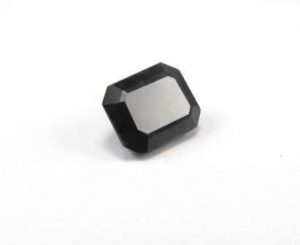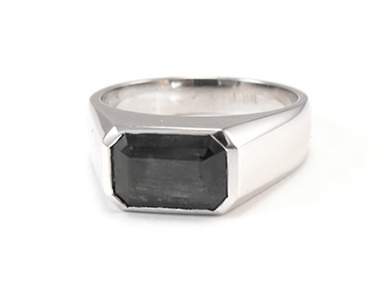Look, if you really want a black diamond it’s your choice but I’m not that keen – and here’s why!
Once upon a time there was a heap of leftover black carbon crystals that nobody wanted and nobody knew what to do with. Then along came a clever marketing fairy who said, “Let’s think of a way of making them really popular so we can charge lots of money for them.” And lo! black diamond jewellery was born!
What are black diamonds? They are porous composites of tiny black crystals containing graphite and carbon and some other stuff!
They are only found in the Central African Republic and Brazil – in places not associated with gem quality diamonds. Whereas a gem quality diamond is a single crystal, a black diamond is made of lots of mashed up crystals which means light cannot be refracted.
 When I started off as a jeweller 35 years ago, black diamonds were never seen and probably would have been consigned to the dustbin if they had been. Their polycrystalline structure means that they consist of a very high number of inclusions (flaws) – something that would be very undesirable in a white diamond – and are very porous which means they are very brittle and susceptible to breaking. This is why I wouldn’t recommend them for everyday wear in a ring.
When I started off as a jeweller 35 years ago, black diamonds were never seen and probably would have been consigned to the dustbin if they had been. Their polycrystalline structure means that they consist of a very high number of inclusions (flaws) – something that would be very undesirable in a white diamond – and are very porous which means they are very brittle and susceptible to breaking. This is why I wouldn’t recommend them for everyday wear in a ring.
Last time a client came to me asking about a black diamond, we got a couple of black diamonds and a couple of black sapphires to compare. The client specifically wanted a black stone in a wedding ring for her husband but we dismissed using onyx as this would have been too soft. Sapphires of all colours are hard and resistant, making them ideal for daily wear.
When we compared the black diamonds and sapphires there was no contest. It was partly due to the lack of uniform colour throughout the diamonds (we may have been sent bad samples) which meant they had a slightly mottled look.
But the main reason was durability. The porosity of the diamonds was obvious, whereas the sapphires exuded quality and sparkle. What’s more, they also gave off brilliant blue flashes along the very outer edges, whilst still appearing black, making them really very interesting and unusual.
Another black stone alternative that we didn’t obtain on this occasion could have been a black spinel which is also hard wearing enough to be worn every day and is a naturally occurring stone often found amongst sapphire and ruby deposits.
 So whilst Carrie Bradshaw and other more real-life celebrities might not mind that the black diamond in their engagement ring isn’t destined to last a lifetime, most normal people usually aim towards a marriage that does. I hand make jewellery that’s designed to last forever so you’ll excuse me if I try to steer you away from the black diamond fad.
So whilst Carrie Bradshaw and other more real-life celebrities might not mind that the black diamond in their engagement ring isn’t destined to last a lifetime, most normal people usually aim towards a marriage that does. I hand make jewellery that’s designed to last forever so you’ll excuse me if I try to steer you away from the black diamond fad.
Check out the stones above and see if you can tell which is the diamond and which is the sapphire, based on what you’ve just learnt. Then take a look at the black sapphire ring I made, below.

